Statistics Assignment: Time Series, Regression, and Hypothesis Testing
VerifiedAdded on 2022/08/25
|16
|592
|18
Homework Assignment
AI Summary
This statistics assignment analyzes time series data, performs regression analysis, and conducts hypothesis tests. The assignment begins with an analysis of U.S. craft beer production from 2004 to 2015, calculating index numbers and interpreting the results. It then moves on to a student-provided tim...

Running head: STATISTICS
Statistics
Name of the Student
Name of the University
Student ID
Statistics
Name of the Student
Name of the University
Student ID
Paraphrase This Document
Need a fresh take? Get an instant paraphrase of this document with our AI Paraphraser

1STATISTICS
Table of Contents
Time series.......................................................................................................................................2
Simple Linear Regression................................................................................................................6
Hypothesis and Test.......................................................................................................................10
Table of Contents
Time series.......................................................................................................................................2
Simple Linear Regression................................................................................................................6
Hypothesis and Test.......................................................................................................................10

2STATISTICS
Time series
1.1)
Table 1: Index number (base year 2004)
Index number for 2015 can be interpreted as recorded production of craft beer in 2015 is
420.58 percent of the craft beer production recorded in 2004.
1.2)
This is an example of quantity index.
1.3)
Time series
1.1)
Table 1: Index number (base year 2004)
Index number for 2015 can be interpreted as recorded production of craft beer in 2015 is
420.58 percent of the craft beer production recorded in 2004.
1.2)
This is an example of quantity index.
1.3)
⊘ This is a preview!⊘
Do you want full access?
Subscribe today to unlock all pages.

Trusted by 1+ million students worldwide
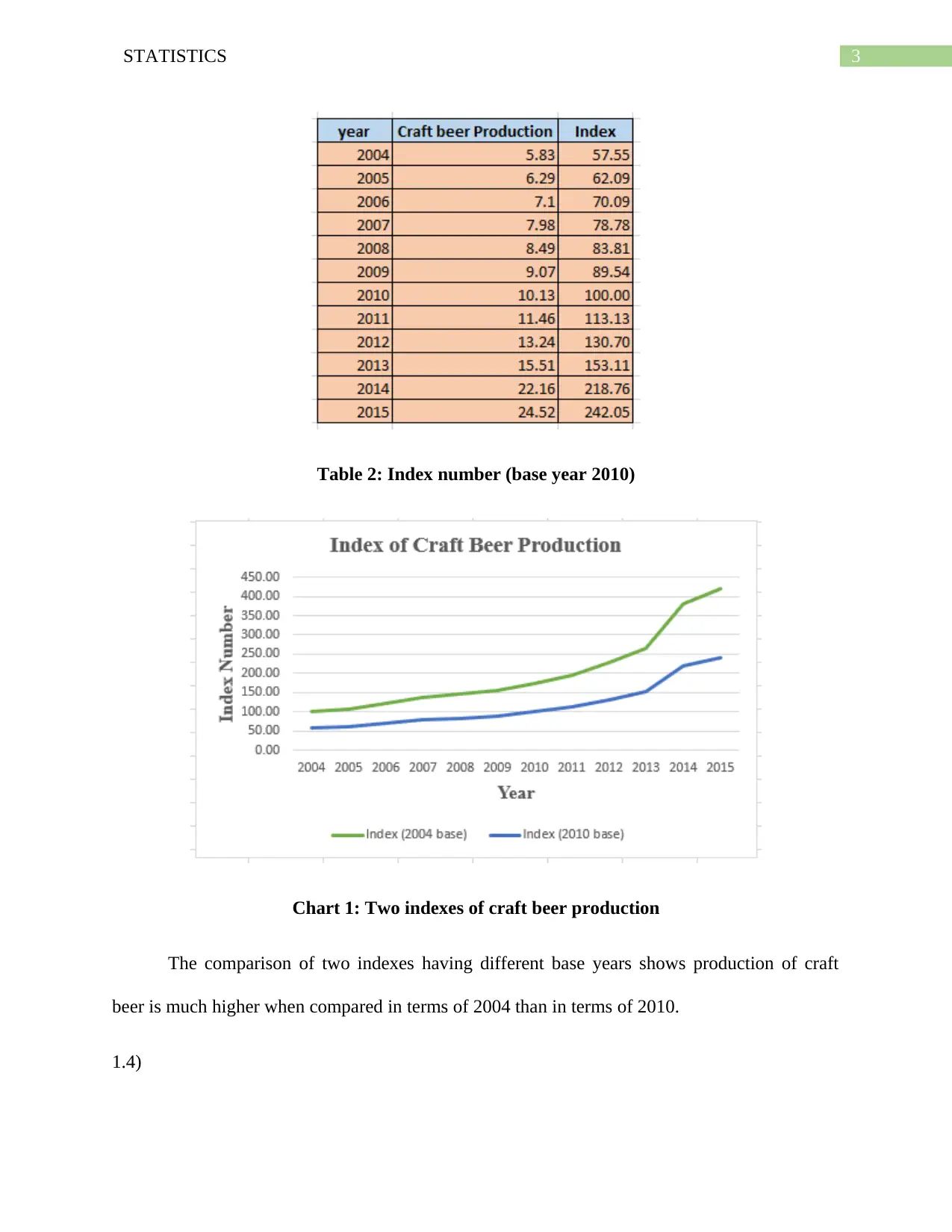
3STATISTICS
Table 2: Index number (base year 2010)
Chart 1: Two indexes of craft beer production
The comparison of two indexes having different base years shows production of craft
beer is much higher when compared in terms of 2004 than in terms of 2010.
1.4)
Table 2: Index number (base year 2010)
Chart 1: Two indexes of craft beer production
The comparison of two indexes having different base years shows production of craft
beer is much higher when compared in terms of 2004 than in terms of 2010.
1.4)
Paraphrase This Document
Need a fresh take? Get an instant paraphrase of this document with our AI Paraphraser
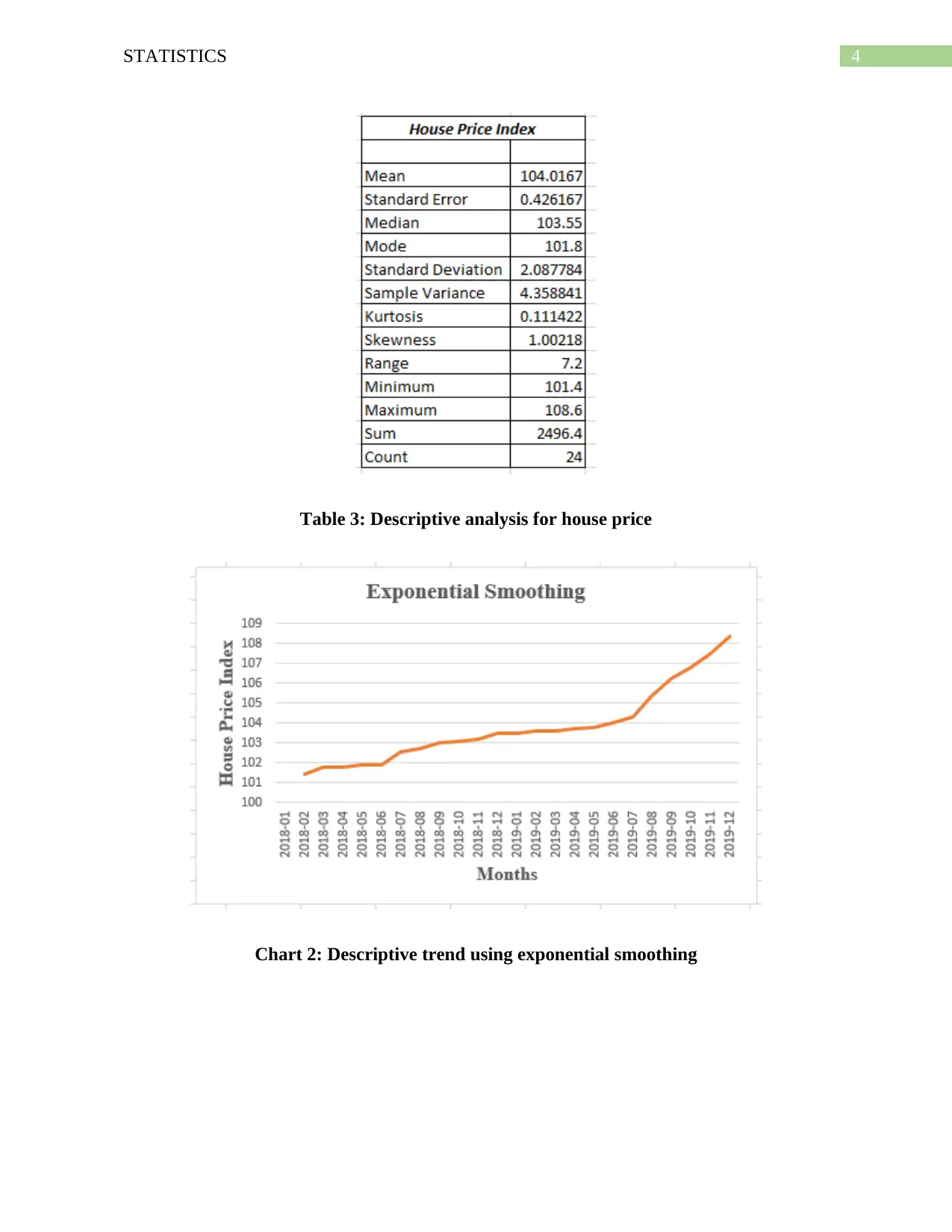
4STATISTICS
Table 3: Descriptive analysis for house price
Chart 2: Descriptive trend using exponential smoothing
Table 3: Descriptive analysis for house price
Chart 2: Descriptive trend using exponential smoothing

5STATISTICS
Chart 3: Descriptive trend using index number
Both exponential and index number shows an upward rising trend for house price
1.5)
Table 4: Forecasted house price index for next year
Chart 3: Descriptive trend using index number
Both exponential and index number shows an upward rising trend for house price
1.5)
Table 4: Forecasted house price index for next year
⊘ This is a preview!⊘
Do you want full access?
Subscribe today to unlock all pages.

Trusted by 1+ million students worldwide

6STATISTICS
Chart 4: Comparison of forecast result
Moving average gives a better fit for the forecasted model relative to trend
Simple Linear Regression
2.1)
Dependent variable: Early pay
Independent variable: Academic Rep. Score
2.2)
Chart 4: Comparison of forecast result
Moving average gives a better fit for the forecasted model relative to trend
Simple Linear Regression
2.1)
Dependent variable: Early pay
Independent variable: Academic Rep. Score
2.2)
Paraphrase This Document
Need a fresh take? Get an instant paraphrase of this document with our AI Paraphraser
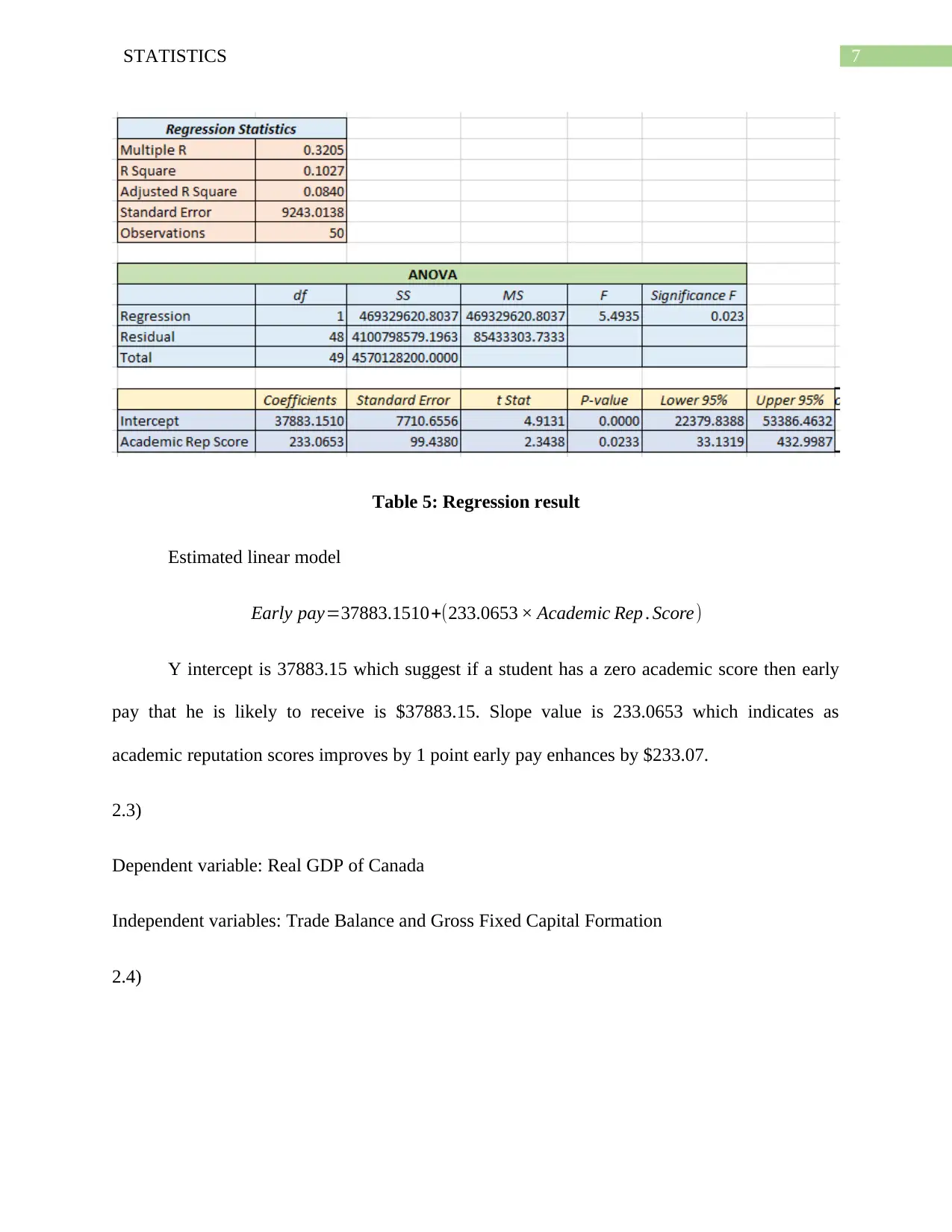
7STATISTICS
Table 5: Regression result
Estimated linear model
Early pay=37883.1510+(233.0653 × Academic Rep . Score)
Y intercept is 37883.15 which suggest if a student has a zero academic score then early
pay that he is likely to receive is $37883.15. Slope value is 233.0653 which indicates as
academic reputation scores improves by 1 point early pay enhances by $233.07.
2.3)
Dependent variable: Real GDP of Canada
Independent variables: Trade Balance and Gross Fixed Capital Formation
2.4)
Table 5: Regression result
Estimated linear model
Early pay=37883.1510+(233.0653 × Academic Rep . Score)
Y intercept is 37883.15 which suggest if a student has a zero academic score then early
pay that he is likely to receive is $37883.15. Slope value is 233.0653 which indicates as
academic reputation scores improves by 1 point early pay enhances by $233.07.
2.3)
Dependent variable: Real GDP of Canada
Independent variables: Trade Balance and Gross Fixed Capital Formation
2.4)
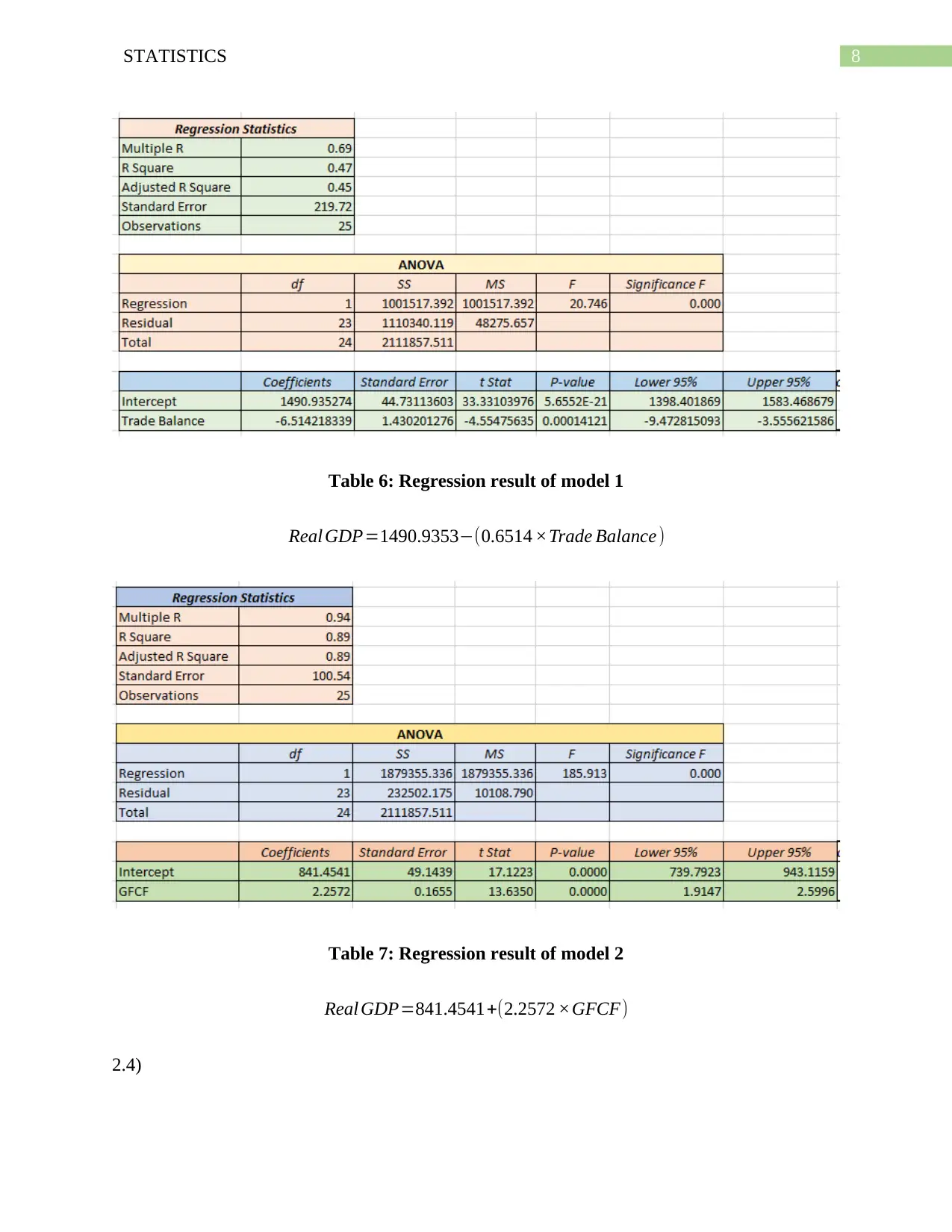
8STATISTICS
Table 6: Regression result of model 1
Real GDP=1490.9353−(0.6514 ×Trade Balance )
Table 7: Regression result of model 2
Real GDP=841.4541+(2.2572 ×GFCF)
2.4)
Table 6: Regression result of model 1
Real GDP=1490.9353−(0.6514 ×Trade Balance )
Table 7: Regression result of model 2
Real GDP=841.4541+(2.2572 ×GFCF)
2.4)
⊘ This is a preview!⊘
Do you want full access?
Subscribe today to unlock all pages.

Trusted by 1+ million students worldwide
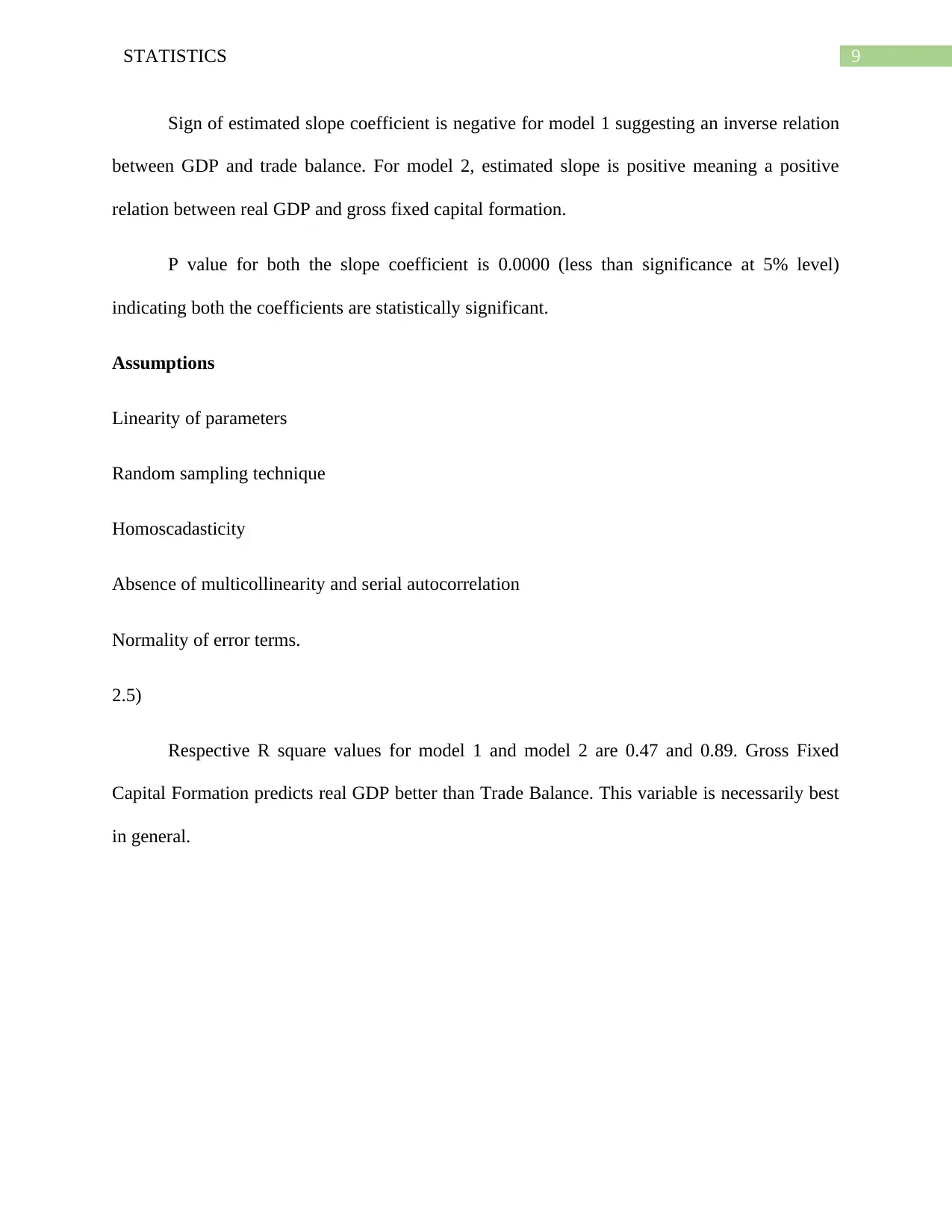
9STATISTICS
Sign of estimated slope coefficient is negative for model 1 suggesting an inverse relation
between GDP and trade balance. For model 2, estimated slope is positive meaning a positive
relation between real GDP and gross fixed capital formation.
P value for both the slope coefficient is 0.0000 (less than significance at 5% level)
indicating both the coefficients are statistically significant.
Assumptions
Linearity of parameters
Random sampling technique
Homoscadasticity
Absence of multicollinearity and serial autocorrelation
Normality of error terms.
2.5)
Respective R square values for model 1 and model 2 are 0.47 and 0.89. Gross Fixed
Capital Formation predicts real GDP better than Trade Balance. This variable is necessarily best
in general.
Sign of estimated slope coefficient is negative for model 1 suggesting an inverse relation
between GDP and trade balance. For model 2, estimated slope is positive meaning a positive
relation between real GDP and gross fixed capital formation.
P value for both the slope coefficient is 0.0000 (less than significance at 5% level)
indicating both the coefficients are statistically significant.
Assumptions
Linearity of parameters
Random sampling technique
Homoscadasticity
Absence of multicollinearity and serial autocorrelation
Normality of error terms.
2.5)
Respective R square values for model 1 and model 2 are 0.47 and 0.89. Gross Fixed
Capital Formation predicts real GDP better than Trade Balance. This variable is necessarily best
in general.
Paraphrase This Document
Need a fresh take? Get an instant paraphrase of this document with our AI Paraphraser

10STATISTICS
Hypothesis and Test
3.1)
a)
Hypothesis and Test
3.1)
a)
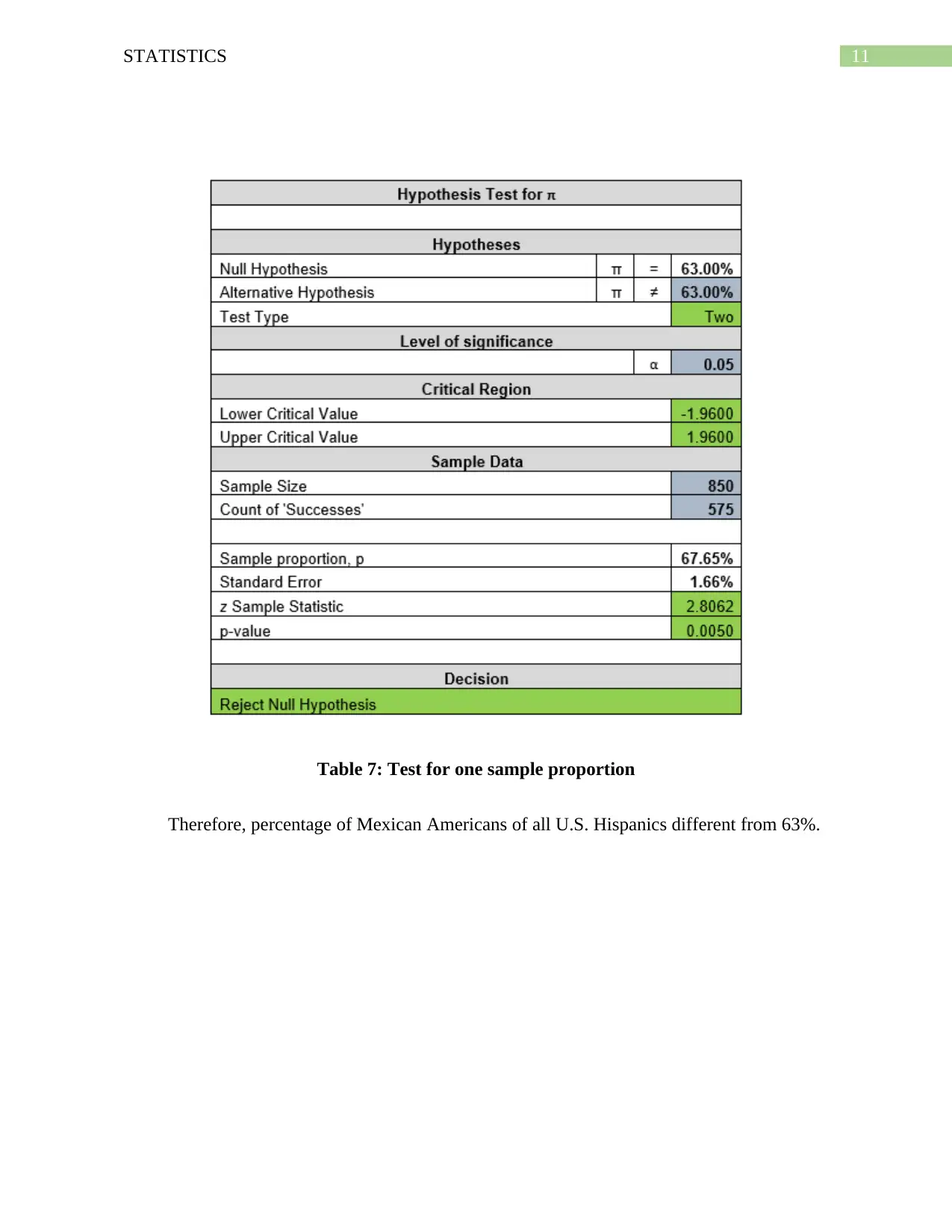
11STATISTICS
Table 7: Test for one sample proportion
Therefore, percentage of Mexican Americans of all U.S. Hispanics different from 63%.
Table 7: Test for one sample proportion
Therefore, percentage of Mexican Americans of all U.S. Hispanics different from 63%.
⊘ This is a preview!⊘
Do you want full access?
Subscribe today to unlock all pages.

Trusted by 1+ million students worldwide
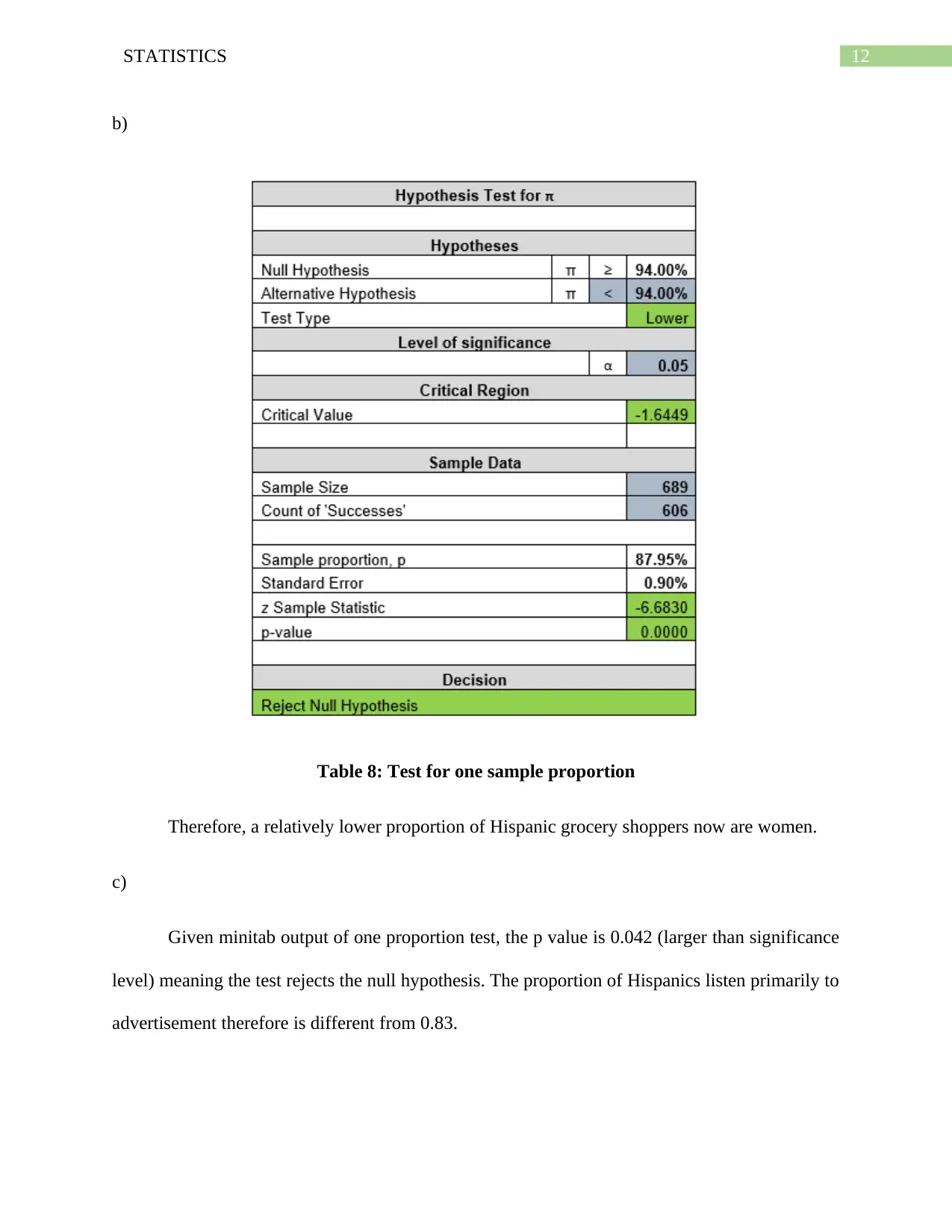
12STATISTICS
b)
Table 8: Test for one sample proportion
Therefore, a relatively lower proportion of Hispanic grocery shoppers now are women.
c)
Given minitab output of one proportion test, the p value is 0.042 (larger than significance
level) meaning the test rejects the null hypothesis. The proportion of Hispanics listen primarily to
advertisement therefore is different from 0.83.
b)
Table 8: Test for one sample proportion
Therefore, a relatively lower proportion of Hispanic grocery shoppers now are women.
c)
Given minitab output of one proportion test, the p value is 0.042 (larger than significance
level) meaning the test rejects the null hypothesis. The proportion of Hispanics listen primarily to
advertisement therefore is different from 0.83.
Paraphrase This Document
Need a fresh take? Get an instant paraphrase of this document with our AI Paraphraser
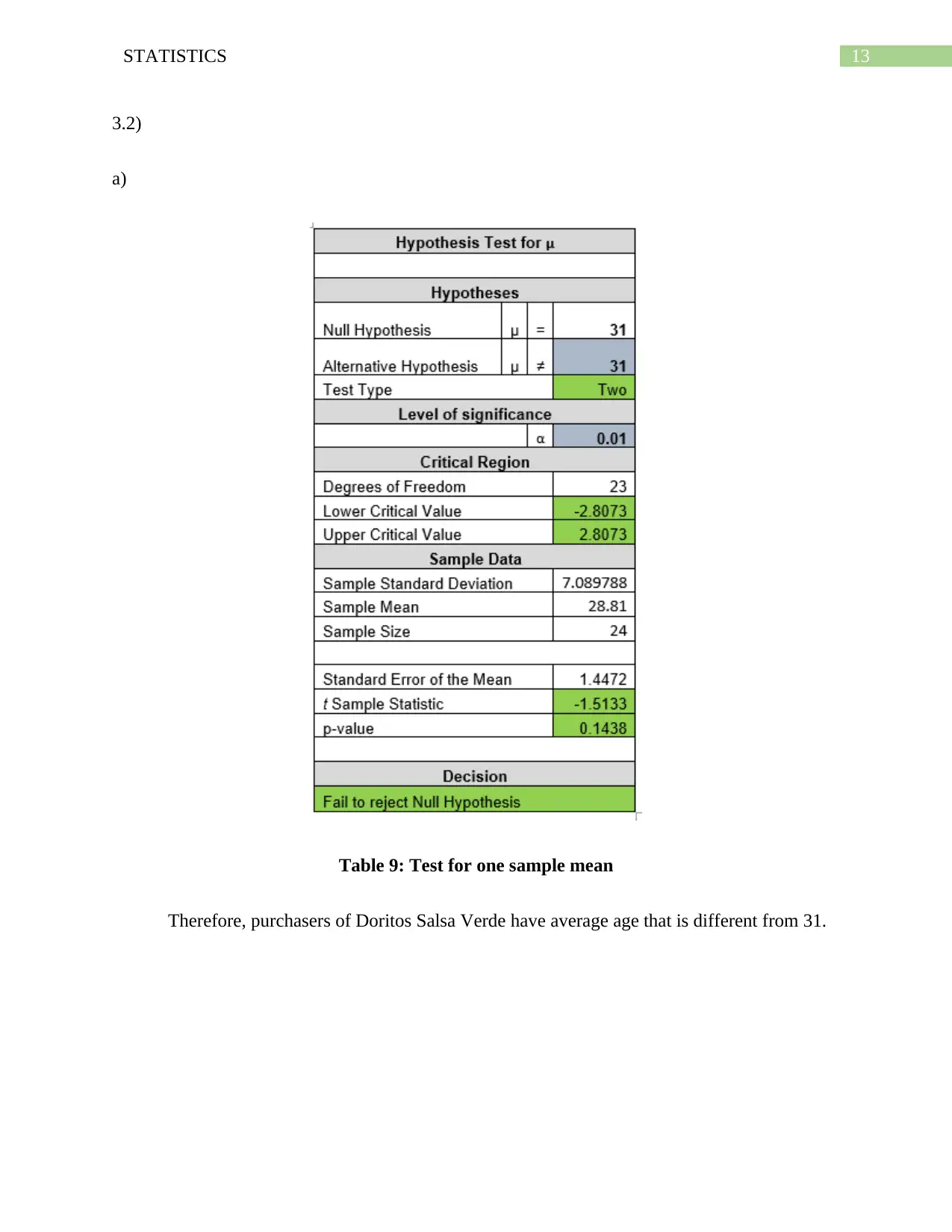
13STATISTICS
3.2)
a)
Table 9: Test for one sample mean
Therefore, purchasers of Doritos Salsa Verde have average age that is different from 31.
3.2)
a)
Table 9: Test for one sample mean
Therefore, purchasers of Doritos Salsa Verde have average age that is different from 31.
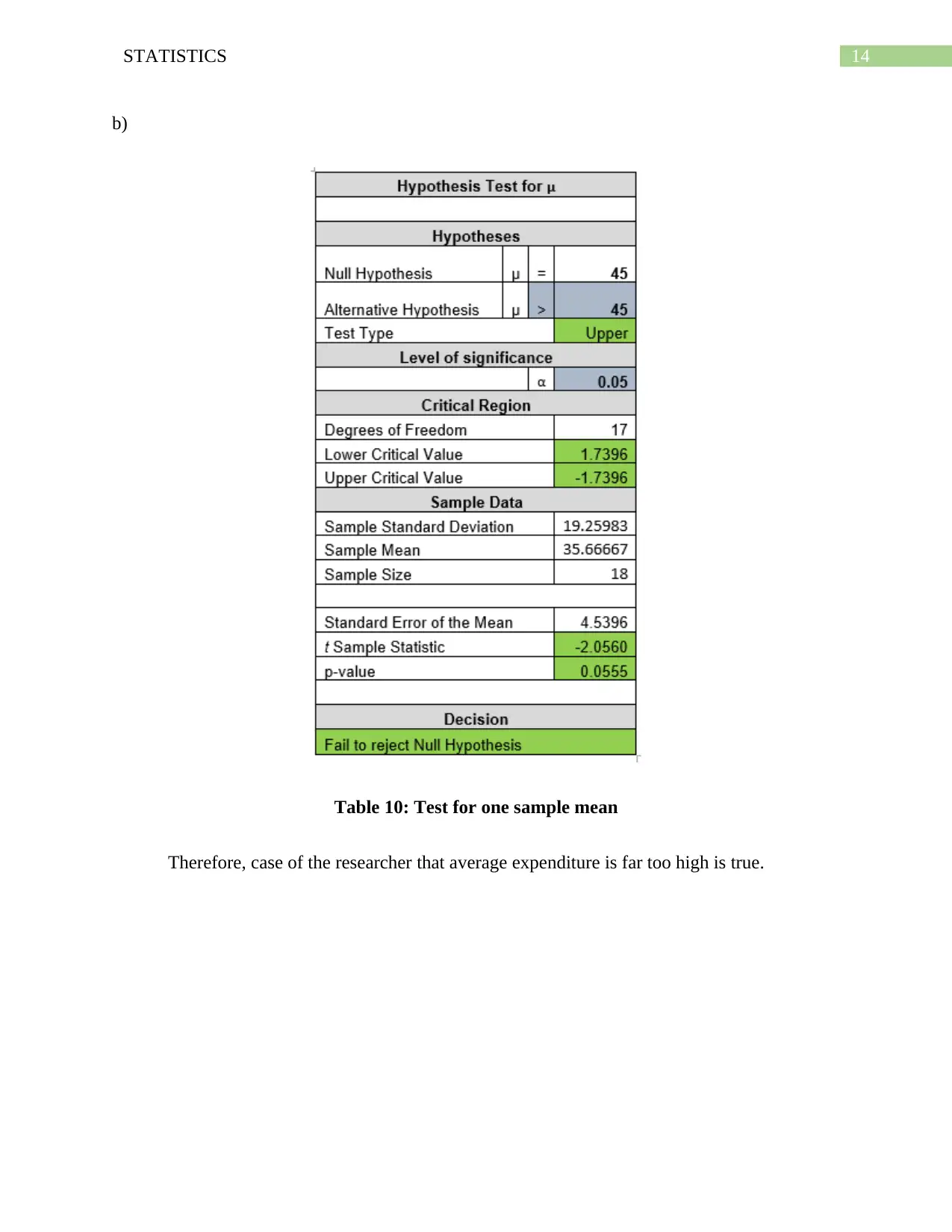
14STATISTICS
b)
Table 10: Test for one sample mean
Therefore, case of the researcher that average expenditure is far too high is true.
b)
Table 10: Test for one sample mean
Therefore, case of the researcher that average expenditure is far too high is true.
⊘ This is a preview!⊘
Do you want full access?
Subscribe today to unlock all pages.

Trusted by 1+ million students worldwide

15STATISTICS
1 out of 16
Related Documents
Your All-in-One AI-Powered Toolkit for Academic Success.
+13062052269
info@desklib.com
Available 24*7 on WhatsApp / Email
![[object Object]](/_next/static/media/star-bottom.7253800d.svg)
Unlock your academic potential
© 2024 | Zucol Services PVT LTD | All rights reserved.





